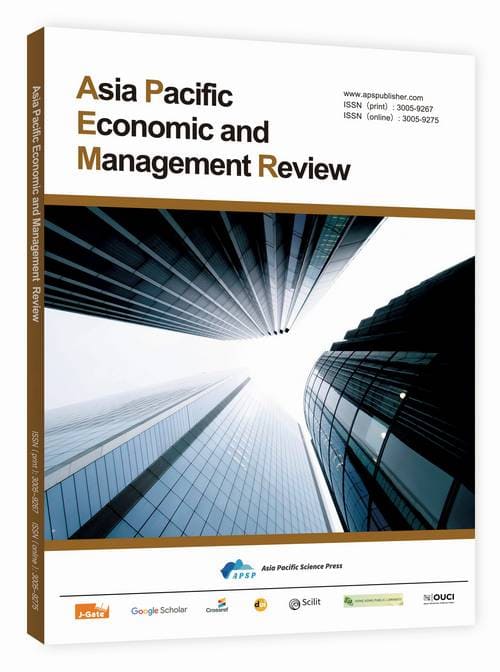The Influence and Mechanism of ESG Peer Effect on Green Innovation of Heavy-Polluting Enterprises
DOI:
https://doi.org/10.62177/apemr.v2i5.623Keywords:
ESG Ratings, Peer Effects, Green Technology Innovation, Financing Constraints, Information AsymmetryAbstract
With the establishment of the Chinese "dual-carbon" goal, green innovation is becoming increasingly important for enterprises, and ESG performance provides opportunities for green innovation development by conveying non-financial information to the market. Although studies have demonstrated that ESG performance impacts green innovation, it is still necessary to clarify the peer effect perspective of this relationship. Thus, from the standpoint of industry spillovers, this article examines how peer firms' publication of ESG ratings affects target firms' innovation in green technologies. The research object for the paper is the listed businesses of major polluters in the Chinese A-share market between 2009 and 2022. It empirically examines the impact of peer ESG disclosure on corporate green innovation and the mechanism of its role. The results show that there is indeed a peer effect on ESG disclosure of heavy polluters, and corporate ESG performance is affected by ESG ratings of peers. Meanwhile, the peer effect promotes improving the green innovation level of target companies. It still holds after robustness tests. The mediating mechanism test shows that the ESG peer effect promotes green innovation by alleviating financing constraints, mitigating information asymmetry, and increasing firms' green awareness. Heterogeneity analysis finds that the impact of ESG peer effects on green innovation is more significant in State-owned firms, large-scale firms, and firms in the east-central region.
Downloads
References
Adhikari, B. K., & Agrawal, A. (2018). Peer influence on payout policies. Journal of Corporate Finance, 48, 615–637.
Amihud, Y. (2002). Illiquidity and stock returns: Cross-section and time-series effects. Journal of Financial Markets, 5(1), 31–56.
Amihud, Y., & Mendelson, H. (1997). Market microstructure and securities values: Evidence from the Tel Aviv Stock Exchange. Journal of Financial Economics, 45(3), 365–390.
Bazrafshan, E. (2023). The role of ESG ranking in retail and institutional investors' attention and trading behavior. Finance Research Letters, 58, 104551.
Bustamante, M. C., & Fresard, L. (2021). Does firm investment respond to peers' investment? Management Science, 67(8), 4703–4724.
Cai, Y., Pan, C. H., & Statman, M. (2016). Why do countries matter so much in corporate social performance? Journal of Corporate Finance, 41, 591–609.
Deng, P., Wen, J., He, W., Chen, Y.-E., & Wang, Y.-P. (2023). Capital market opening and ESG performance. Emerging Markets Finance and Trade, 59(13), 3866–3876.
Drempetic, S., Klein, C., & Zwergel, B. (2020). The influence of firm size on the ESG score: Corporate sustainability ratings under review. Journal of Business Ethics, 167(2), 333–360.
Foroughi, P., Marcus, A. J., Nguyen, V., & Tehranian, H. (2022). Peer effects in corporate governance practices: Evidence from universal demand laws. Review of Financial Studies, 35(1), 132–167.
Grennan, J. (2019). Dividend payments as a response to peer influence. Journal of Financial Economics, 131(3), 549–570.
Gu, Y., Ben, S., & Lv, J. (2022). Peer effect in merger and acquisition activities and its impact on corporate sustainable development: Evidence from China. Sustainability, 14(7), 4210.
Hadlock, C. J., & Pierce, J. R. (2010). New evidence on measuring financial constraints: Moving beyond the KZ index. Review of Financial Studies, 23(5), 1909–1940.
Huang, X., Ren, Y., & Ren, X. (2024). Legal background executives, corporate governance and corporate ESG performance. Finance Research Letters, 69, 105125.
Jiao, J.-l., Zhang, X.-l., & Tang, Y.-s. (2020). What factors determine the survival of green innovative enterprises in China? —A method based on fsQCA. Technology in Society, 62, 101314.
Li, J., & Xu, X. (2024). Can ESG rating reduce corporate carbon emissions? —An empirical study from Chinese listed companies. Journal of Cleaner Production, 434, 140094.
Li, J., Lian, G., & Xu, A. (2023). How do ESG affect the spillover of green innovation among peer firms? Mechanism discussion and performance study. Journal of Business Research, 158, 113676.
Lieberman, M. B., & Asaba, S. (2006). Why do firms imitate each other? Academy of Management Review, 31(2), 366–385.
Liu, M., Lu, J., Liu, Q., Wang, H., Yang, Y., & Fang, S. (2024). The impact of executive cognitive characteristics on a firm's ESG performance: An institutional theory perspective. Journal of Management and Governance. Advance online publication.
Lu, Y., Wang, R., Shi, Y., Su, C., Yuan, J., Johnson, A. C., Jenkins, A., Ferrier, R. C., Chen, D., Tian, H., Melillo, J., Song, S., & Ellison, A. M. (2018). Interaction between pollution and climate change augments ecological risk to a coastal ecosystem. Ecosystem Health and Sustainability, 4(7), 161–168.
Meira, E., Cunha, F. A. F. S., Orsato, R. J., Miralles-Quiros, M. M., & Miralles-Quiros, J. L. (2023). The added value and differentiation among ESG investment strategies in stock markets. Business Strategy and the Environment, 32(4), 1816–1834.
Ni, J., Jin, S., Hu, Y., & Zhang, L. (2023). Informative or distracting: CSR disclosure of peer firms and analyst forecast accuracy. International Review of Financial Analysis, 87, 102592.
Pastore, L. M., & Stambaugh, R. F. (2003). Liquidity risk and expected stock returns. Journal of Political Economy, 111(3), 642–685.
Sahin, O., Bax, K., Czado, C., & Paterlini, S. (2022). Environmental, Social, Governance scores and the Missing pillar—Why does missing information matter? Corporate Social Responsibility and Environmental Management, 29(5), 1782–1798.
Shin, H., Kim, S.-I., Park, S., & Shin, H. (2019). The effect of industry homogeneity on the magnitude of post-earnings announcement drift: Evidence from Korea. Asian Academy of Management Journal of Accounting and Finance, 15(1), 107–127.
Siew, R. Y. J., Balatbat, M. C. A., & Carmichael, D. G. (2016). The impact of ESG disclosures and institutional ownership on market information asymmetry. Asia-Pacific Journal of Accounting & Economics, 23(4), 432–448.
Tan, X., Yan, Y., & Dong, Y. (2022). Peer effect in green credit induced green innovation: An empirical study from China's Green Credit Guidelines. Resources Policy, 76, 102619.
Velte, P., & Stawinoga, M. (2020). Do chief sustainability officers and CSR committees influence CSR-related outcomes? A structured literature review based on empirical-quantitative research findings. Journal of Management Control, 31(4), 333–377.
Verdi, S., Marquand, A. F., Schott, J. M., & Cole, J. H. (2021). Beyond the average patient: How neuroimaging models can address heterogeneity in dementia. Brain, 144(9), 2946–2953.
Vural-Yavas, C. (2021). Economic policy uncertainty, stakeholder engagement, and environmental, social, and governance practices: The moderating effect of competition. Corporate Social Responsibility and Environmental Management, 28(1), 82–102.
Wang, J., Wu, G., Huang, X., Sun, D., & Song, Z. (2023). Peer effects of corporate product quality information disclosure: Learning and competition. Journal of International Financial Markets, Institutions & Money, 88, 101832.
Wang, Z., & Xing, T. (2024). ESG information disclosure, stock price informativeness and corporate digital transformation. Applied Economics. Advance online publication.
Wu, H., Zhang, K., & Li, R. (2024). ESG score, analyst coverage and corporate resilience. Finance Research Letters, 62, 105179.
Xu, H., & Wu, Y. (2022). The China trade shock and the ESG performances of US firms. arXiv.
Zell, E., & Alicke, M. D. (2010). Comparisons over time: Temporal trajectories, social comparison, and self-evaluation. European Journal of Social Psychology, 40(3), 375–382.
Zhai, X., & An, Y. (2020). Analyzing influencing factors of green transformation in China's manufacturing industry under environmental regulation: A structural equation model. Journal of Cleaner Production, 251, 119760.
Zhang, B., Wang, Z., & Lai, K.-h. (2015). Mediating effect of managers' environmental concern: Bridge between external pressures and firms' practices of energy conservation in China. Journal of Environmental Psychology, 43, 203–215.
Downloads
How to Cite
Issue
Section
License
Copyright (c) 2025 Mingyue Li, Xin Wang

This work is licensed under a Creative Commons Attribution-NonCommercial 4.0 International License.

















